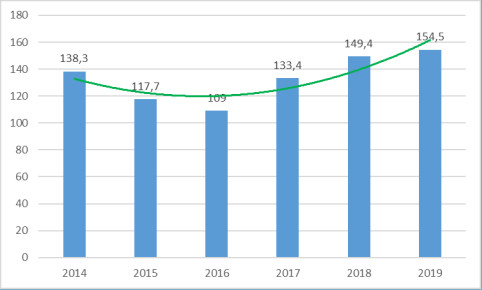When it comes to Russia as an exporter, the first thing that is associated with this concept is oil and gas.
Historically, due to natural raw materials, the products of this sector are the leader in supplies to other countries.
But the current situation in the world with the imposition of sanctions and the instability of prices in the oil market is steadily leading to the development of a non-resource export market.
The non-commodity market is divided into three limits:
lower limit are products of simple processing: agricultural products (fruits, grains, vegetables, etc.), chemical products and fertilizers.
average limit — goods obtained through more complex processing: meat, vegetable oil, flour, building materials, etc.
upper limit — goods for the production of which deep processing of materials is required: pharmaceutical products, mechanical engineering, food products (bakery confectionery, cheese, etc.), light industry, furniture.
In 2019, total Russian exports amounted to USD 422,777 million, down 6.04% from 2018 levels.
At the same time, Russian non-resource exports reached 154.5 million US dollars, adding 3.5% of the volume of 2018.

Since 2016, there has been a stable growth in the non-resource export segment. First of all, this was facilitated by the state program of import substitution, adopted after the introduction of sanctions against Russia.
The program was aimed at supporting agriculture, mechanical engineering and information technology.
After filling and saturation of the Russian market with domestic goods, the need arose for export.
The growth leaders were the agro-industrial industry, mechanical engineering and the chemical industry.
The largest increase in relation to 2018 was shown by non-food agricultural products: + 25%, timber and paper products and food: + 21% in each segment and metal products: + 18%.
Today, in the export market, Russia is faced with the problem of dependence on the commodity segment due to price volatility. The turnover in general suffers from this.
Based on foreign experience, it is a little easier for small and medium-sized businesses to enter international markets when compared with transnational corporations.
And this sector has tremendous potential.
It is with the aim of expanding participation in foreign economic activity of small and medium-sized enterprises that the Russian Export Center was created in 2015, and today it has become the founder of the Coordination Council for Export Support.
KSPE will study and resolve issues related to export activities, bringing them to the governmental and intergovernmental levels.
The main strategy is to increase the market for non-primary exports until 2030.

